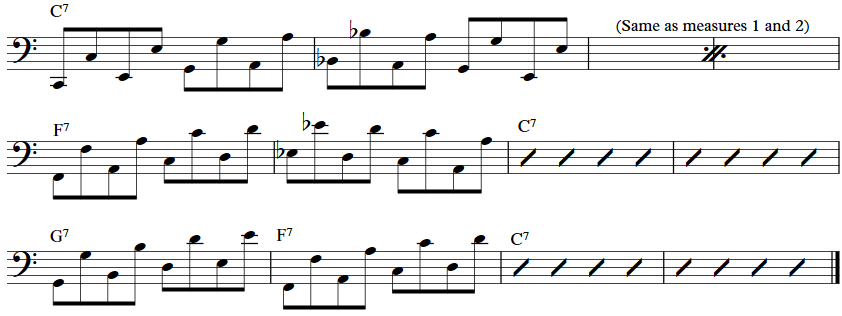In this article we will discuss some specific rock piano tips that you can use in your playing right away. These rock piano tips are meant as a companion offering to our popular lesson “11 Rock Piano Technique Tips.” The tips offered below are just some of the tricks of the trade of every great rock pianist. We’ll discuss some simple rock piano fills, tremolos, and how to use triad shapes to comp over songs with one static chord. Let’s get started!
Rock Piano Tips #1: Classic Rock Fill
All good rock piano players know that as the energy level of a song increases the role of the piano must also respond in kind. One way that this can happen is for the pianist to add faster rhythmic and repetitive comping fills. Often grace notes are used in order to get that authentic rock sound.
Below is a very classic rock pattern that you might use in which a repetitive 16th-note figure is played over a C major or C7 chord. Notice the use of grace notes.
Using a fill like this can definitely help you boost the energy level in your playing, but be careful to use it sparingly or it can sound a bit overdone and distracting.
Rock Piano Tips #2: Tremolos
Tremolos are what some musicians refer to as “shaking” a chord or notes. This can be done in the context of comping or soloing. In order to indicate a tremolo, diagonal lines are drawn through the stem of a note or notes. Some classic rock (and jazz) piano uses of the tremolo include a tremolo on the 5th and 7th of a chord, or a tremolo on a single note while the left hand sustains a chord.
Tremolo on ‘G’ and ‘Bb’ of a C7 chord:
Tremolo on a single note (‘D,’ the 9th of a C7 chord):
Rock Piano Tips #3: Using Triads to Comp Through a Chord
Have you ever encountered a tune that has only one or two chords for the whole tune? Have you struggled to find ways to comp through that same chord without playing the same thing over and over again? Being able to play triad structures through a single chord can help you generate new ideas, build comping grooves, and provide various options for things to play on a single chord.
Let’s say you encounter a song that stays on a C7 chord for multiple measures. The chord scale from which the C7 chord originates is a C mixolydian scale. So we’ll start with the notes from that scale and build the following triadic structures:
Now, using these various triad structures (all of which come from a C mixolydian scale) and some rhythmic variation, we can find various interesting ways to create some comping patterns over a single C7 chord.






